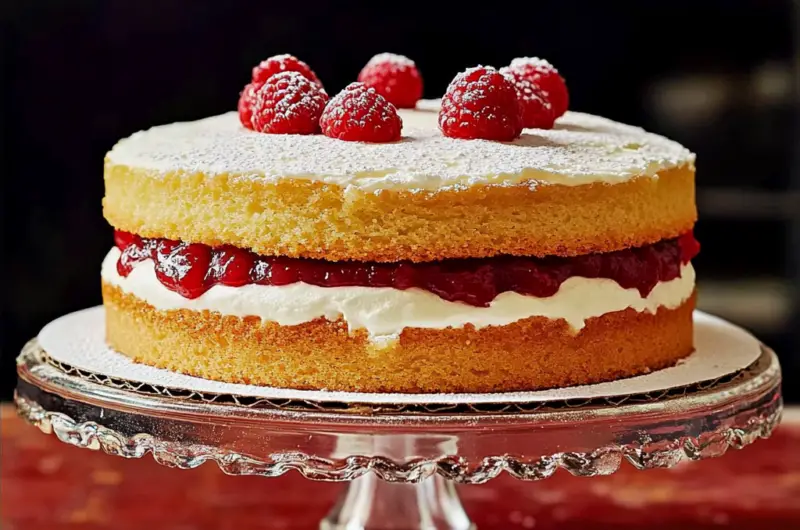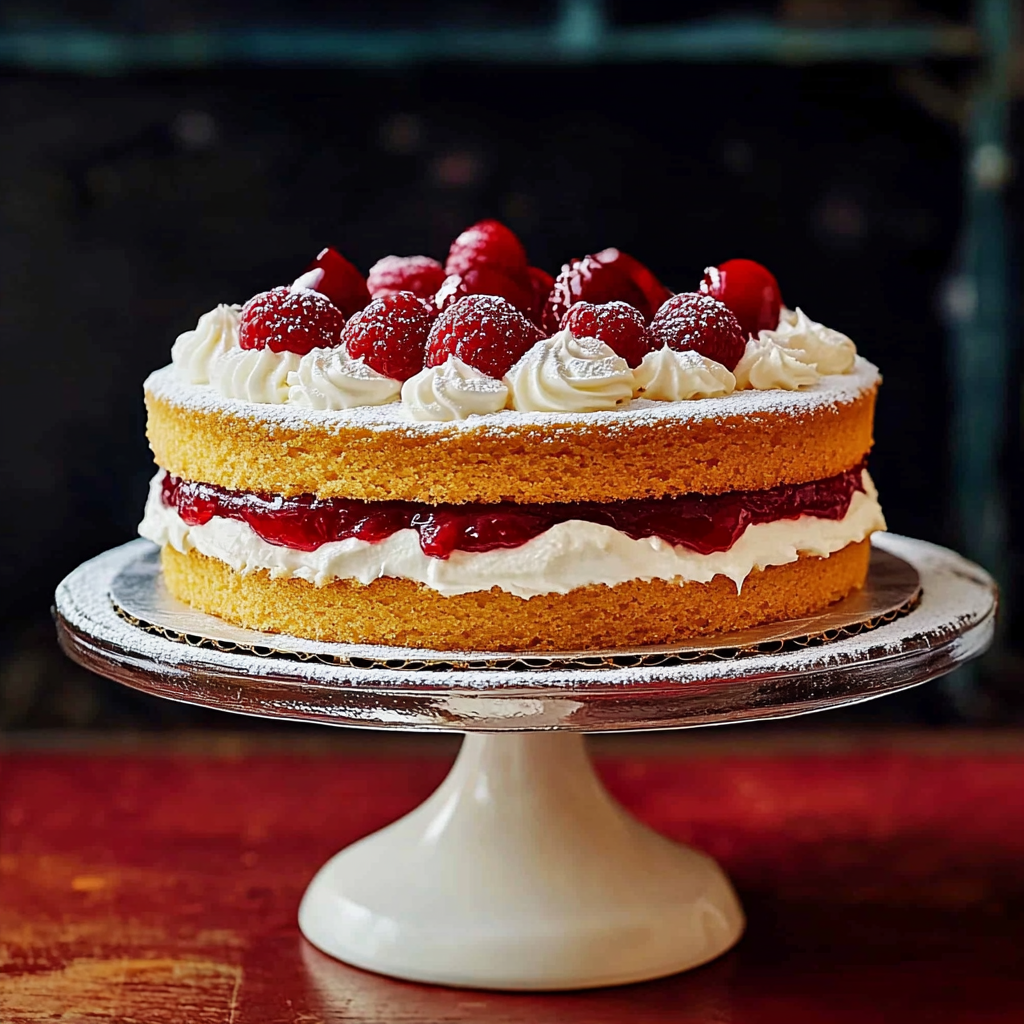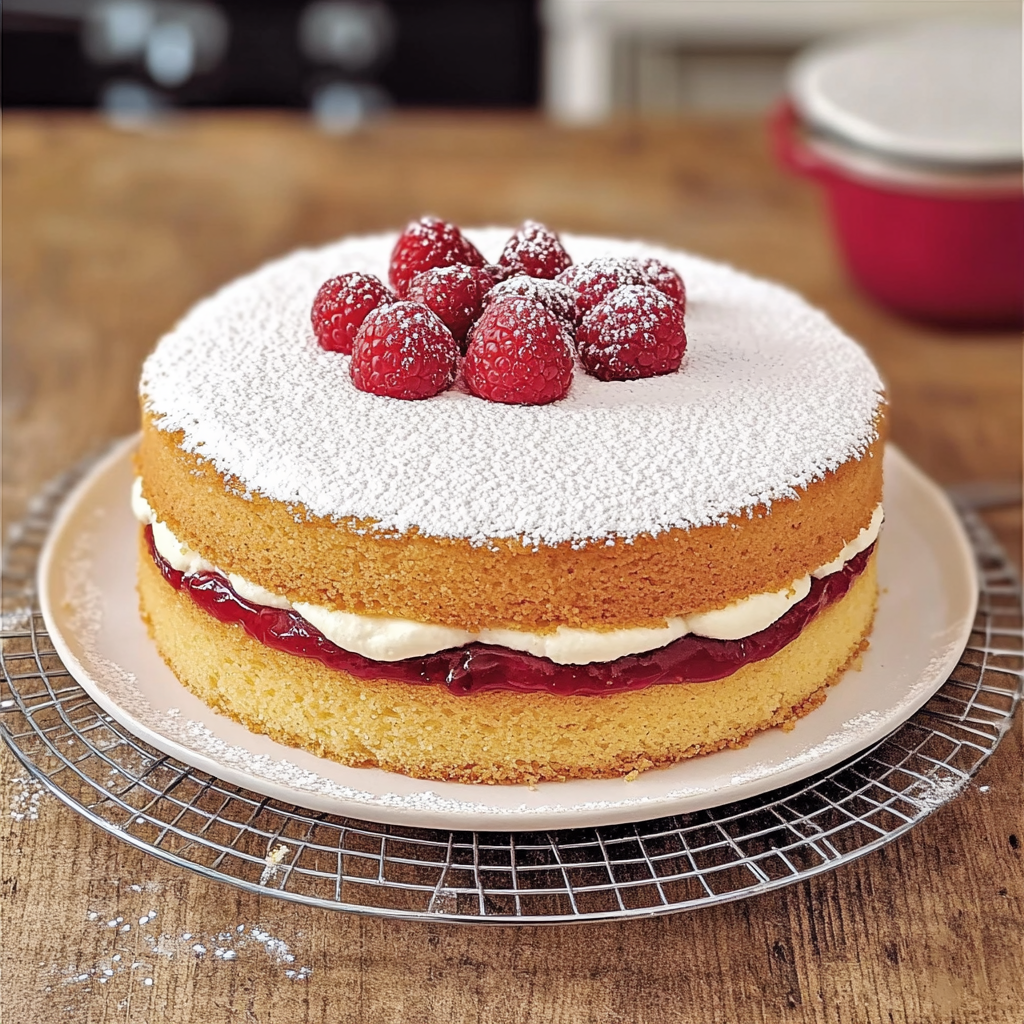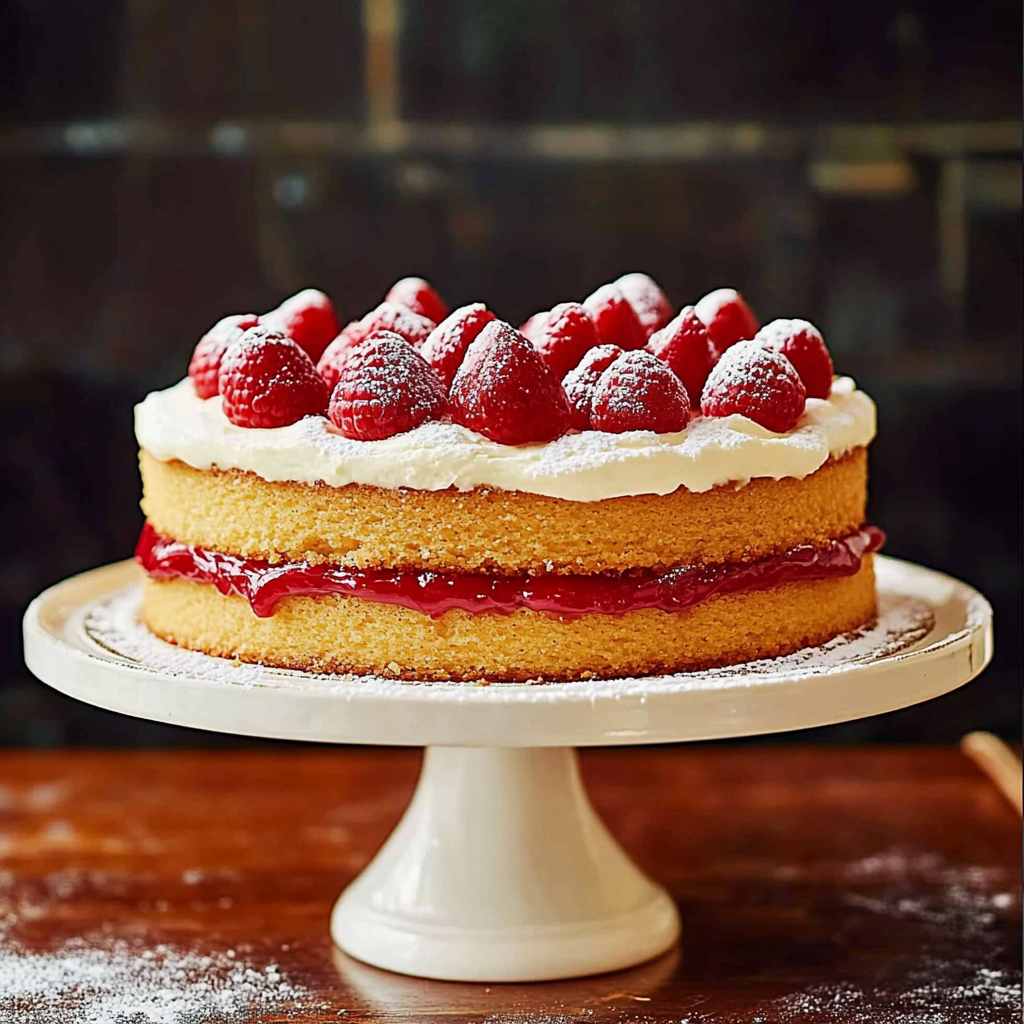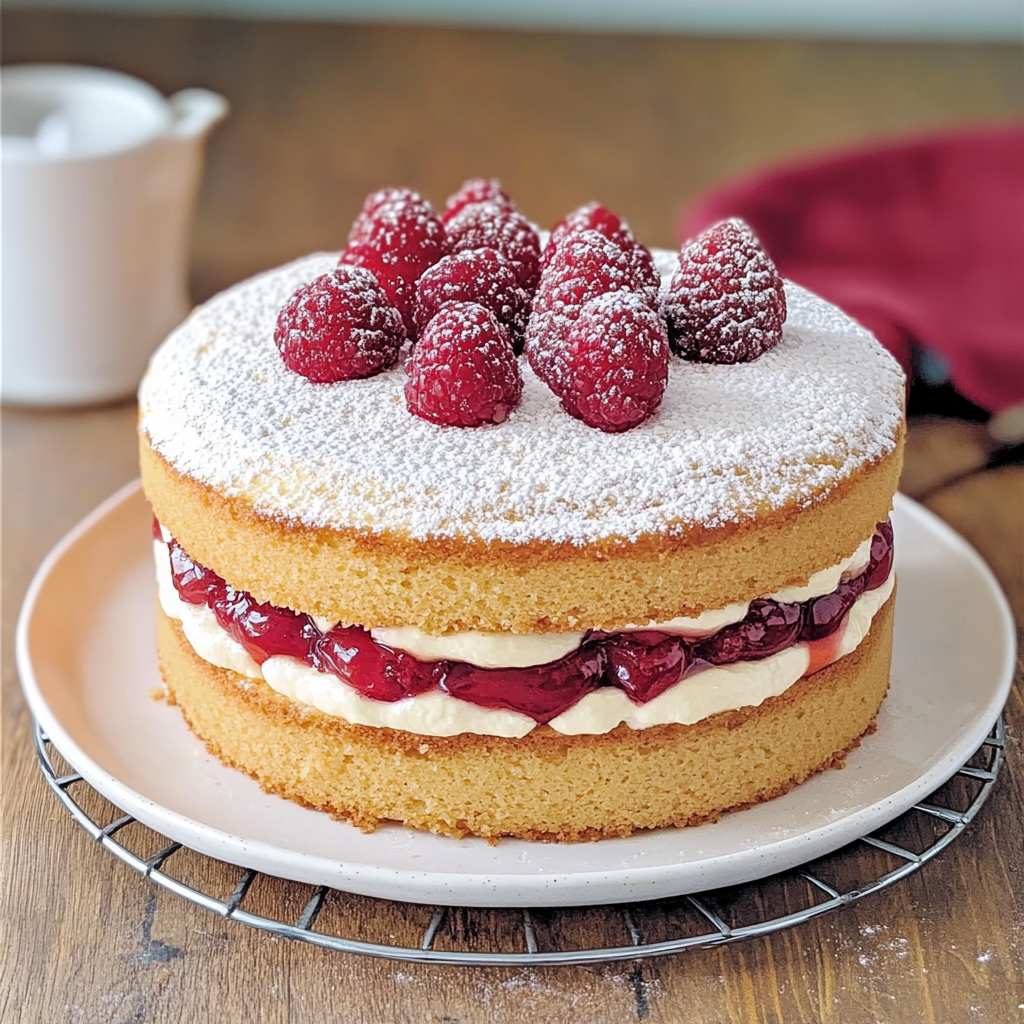Victoria Sponge Cake is a timeless British classic known for its light texture and delightful flavor. This elegant dessert features two layers of soft sponge cake filled with whipped cream and fresh fruit, usually strawberries or raspberries. Ideal for afternoon tea or special gatherings, this recipe promises to impress your guests without requiring extensive baking skills. In this article, you’ll learn not only how to create the perfect Victoria Sponge Cake but also some helpful tips to make your baking experience enjoyable. Whether you’re an experienced baker or just starting out in the kitchen, this recipe is straightforward and guarantees delicious results. With a few simple ingredients and easy-to-follow steps, you can whip up a stunning dessert that will become a favorite in your household. Get ready to indulge in the lightness of fluffy sponge layered with sweet cream; it’s time to bake!
Why You’ll Love This Victoria Sponge Cake
- Quick and Easy: Minimal prep time and straightforward steps make this recipe stress-free, even for novice cooks
- Flavorful and Versatile: Enjoy outstanding flavor with ingredients you can easily customize by adding your favorites or adjusting spices
- Perfect for Any Occasion: Ideal for casual gatherings, holiday celebrations, or weeknight dinners
Ingredients for Victoria Sponge Cake
Here’s what you’ll need to make this delicious dish:
- All-Purpose Flour: Use high-quality flour for the best texture; ensure it’s sifted before measuring.
- Granulated Sugar: This sweetener balances the flavors and helps achieve a fluffy structure in the cake.
- Baking Powder: Essential for leavening; ensure it’s fresh for optimal rise.
- Salt: A small amount enhances overall flavor; don’t skip it.
- Unsalted Butter: Use softened butter at room temperature for easy creaming with sugar.
- Large Eggs: Room-temperature eggs help create a lighter batter.
- Vanilla Extract: Adds a lovely depth of flavor; opt for pure vanilla if possible.
For the Filling:
- Heavy Cream: Whip until soft peaks form; this will add richness between the layers.
- Fresh Strawberries or Raspberries: Choose ripe berries for the best taste; they add freshness to every bite.
The full ingredients list, including measurements, is provided in the recipe card directly below.
Pair this dish with another one of our amazing recipes!
How to Make Victoria Sponge Cake
Follow these simple steps to prepare this delicious dish:
Step 1: Preheat Your Oven
Preheat your oven to 350°F (175°C). Grease two round cake pans with butter or nonstick spray.
Step 2: Prepare Your Batter
In a mixing bowl, cream together the softened unsalted butter and granulated sugar until light and fluffy. Add in large eggs one at a time while continuing to mix.
Step 3: Combine Dry Ingredients
In another bowl, sift together all-purpose flour, baking powder, and salt. Gradually add this mixture into the wet ingredients while mixing until just combined.
Step 4: Add Flavor
Stir in vanilla extract gently into the batter. Be careful not to overmix as it can affect the fluffiness of your cake.
Step 5: Bake Your Cakes
Divide the batter evenly between the two prepared pans. Bake in preheated oven for about 25-30 minutes or until a toothpick inserted into the center comes out clean.
Step 6: Cool and Assemble
Once baked, remove from oven and allow cakes to cool in pans for about ten minutes before transferring them onto wire racks. After they cool completely, spread whipped cream on top of one layer followed by fresh berries before placing the second layer on top.
Transfer to plates and enjoy your homemade cake!
Tips and Tricks
Here are some helpful tips to ensure the best results for your dish:
- Room Temperature Ingredients: Allow eggs and butter to come to room temperature before starting; it helps create a smooth batter.
- Sift Flour Before Measuring: Sifting ensures there are no lumps and allows accurate measurement of ingredients.
- Avoid Overmixing: Mix just until combined; overmixing can result in dense cakes.
For more tasty ideas, explore our recipe collection!
How to Serve Victoria Sponge Cake
This Victoria Sponge Cake is versatile and pairs wonderfully with:
- Whipped Cream: A light and airy topping that enhances the cake’s sweetness and adds a creamy texture.
- Fresh Berries: Juicy berries provide a tart contrast that balances the sweetness of the sponge, making each bite more delightful.
- Custard Sauce: Rich custard drizzled over the cake brings an indulgent touch, perfect for special occasions.
- Icing Sugar Dusting: A simple dusting elevates the presentation, adding a sweet finish without overwhelming the flavors.
Feel free to pair it with your favorite sides for a personalized meal!
Make Ahead and Storage
- Make Ahead: You can bake the Victoria Sponge Cake up to two days in advance. Allow it to cool completely before wrapping it tightly in plastic wrap or storing it in an airtight container at room temperature. This helps retain its moisture and freshness until you are ready to serve.
- Storing: Leftover cake can be stored in an airtight container at room temperature for up to three days. If you wish to prolong its freshness, refrigerate it where it will last up to one week. Always ensure it’s well-covered to prevent it from drying out.
- Reheating: If you prefer your Victoria Sponge Cake warm, preheat your oven to 350°F (175°C). Place the slices on a baking sheet and heat for about five minutes. This method helps maintain the cake’s texture while adding warmth without making it soggy.
Ready for another tasty treat? Try our recipe next!
Suggestions for Victoria Sponge Cake:
Choose the Right Ingredients
Selecting high-quality ingredients is crucial for a successful Victoria Sponge Cake. Using fresh eggs, real butter, and self-raising flour can significantly impact the cake’s texture and flavor. Avoid margarine or low-quality substitutes, as they can alter the cake’s taste and moisture levels. Additionally, opt for fine sugar to ensure a smooth batter. Remember that room temperature ingredients blend better, creating a lighter sponge. Always sift dry ingredients to incorporate air and avoid lumps. This foundational step helps achieve that classic fluffy consistency characteristic of a perfect Victoria Sponge.
Measure Accurately
Precision is vital when baking a Victoria Sponge Cake. To get consistent results, use a digital kitchen scale for weighing your ingredients instead of measuring cups. This method eliminates discrepancies caused by packing flour or sugar into cups. Follow the recipe closely for ingredient ratios; even slight variations can lead to a dense or overly dry cake. Consider using measuring spoons for smaller amounts of baking powder or vanilla extract to enhance accuracy further. Correct measurements ensure that your cake rises beautifully and has the desired texture.
Don’t Overmix the Batter
Overmixing is a common mistake when making Victoria Sponge Cake. Once you add flour to your wet ingredients, mix until just combined; this method helps retain air bubbles created during creaming butter and sugar. If you overmix, gluten develops too much, leading to a tough cake rather than a light and airy one. Gently fold in the flour using a spatula or whisk to keep the batter fluffy. Aim for visible streaks of flour before stopping; this will allow your cake to rise properly while maintaining its delicate crumb.
Cool Properly
Proper cooling is essential for achieving the perfect Victoria Sponge Cake texture. After baking, let the cakes cool in their tins for about 10-15 minutes before transferring them onto wire racks. Cooling in the tins allows them to set without collapsing but be careful not to leave them too long, as they may stick to the pan. Once on the rack, allow them to cool completely before icing or assembling with jam and cream. This method prevents melting or oozing toppings, ensuring each layer remains intact and visually appealing.
FAQs:
What is the origin of Victoria Sponge Cake?
The Victoria Sponge Cake has its roots in England and dates back to the 19th century during Queen Victoria’s reign. Originally known as “Victoria Sandwich,” it became popular as an afternoon tea treat among aristocrats and commoners alike. The cake typically consists of two layers filled with jam and whipped cream, reflecting simplicity yet elegance in British baking traditions. Its historical significance continues today, making it a beloved dessert at tea parties and celebrations across various cultures.
Can I substitute ingredients in my Victoria Sponge Cake?
Yes, you can make substitutions when preparing your Victoria Sponge Cake; however, it’s essential to understand how these changes affect flavor and texture. For instance, if you’re out of self-raising flour, you can use all-purpose flour combined with baking powder (2 teaspoons per cup). If you’re dairy-free, consider plant-based options like coconut oil instead of butter or almond milk instead of cow’s milk. Keep in mind that these substitutions may yield different results but can still create delicious variations of this classic cake.
How do I store leftover Victoria Sponge Cake?
Storing leftover Victoria Sponge Cake correctly ensures it stays fresh longer. If you have any slices left after serving, place them in an airtight container at room temperature for up to three days. For longer storage, wrap individual slices in plastic wrap and freeze them for up to three months. When ready to enjoy again, simply thaw at room temperature before serving. Avoid refrigerating unless necessary since cold temperatures can dry out the cake and affect its delightful texture.
Why did my Victoria Sponge Cake sink?
A sunken Victoria Sponge Cake often results from several factors related to baking techniques or ingredient proportions. One common reason is underbaking; if you pull it out too soon from the oven, it might collapse upon cooling due to insufficient structure development. Another cause could be overmixing your batter; this leads to excessive gluten formation that causes density issues during rising phases. Lastly, ensure your oven temperature is accurate—if it’s too low or fluctuates drastically during baking time, it may result in an uneven rise leading to sinking.
Perfect for any occasion, this recipe will hit the spot!
Conclusion for Victoria Sponge Cake:
In conclusion, mastering the art of baking a delightful Victoria Sponge Cake involves attention to detail regarding ingredients and techniques used throughout the process. From selecting high-quality components to measuring accurately and avoiding overmixing—the key points significantly impact your final product’s success rate! Remember also not to skip proper cooling methods; they play a vital role in achieving that light yet moist texture everyone loves about this classic dessert. By following these suggestions closely while enjoying experimentation along the way, you’ll create stunning cakes worthy of any celebration!
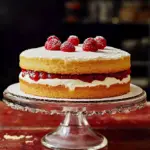
Victoria Sponge Cake
- Total Time: 50 minutes
- Yield: Serves approximately 8 slices 1x
Description
Victoria Sponge Cake is a quintessential British delight that combines simplicity with elegance. This classic dessert boasts a light, airy texture achieved through two layers of fluffy vanilla sponge cake. Sandwiched between these layers is a luscious filling of whipped cream and fresh strawberries or raspberries, making it an irresistible treat perfect for afternoon tea, birthday celebrations, or any special occasion. With its straightforward preparation and common ingredients, even novice bakers can master this recipe. Indulge in the sweet flavors and delightful textures of this beloved cake that will impress your family and friends alike.
Ingredients
- 1 cup all-purpose flour
- 1 cup granulated sugar
- 1 tsp baking powder
- 1/4 tsp salt
- 1/2 cup unsalted butter (softened)
- 2 large eggs (room temperature)
- 2 tsp vanilla extract
- 1 cup heavy cream (for filling)
- Fresh strawberries or raspberries (for filling)
Instructions
- Preheat the oven to 350°F (175°C). Grease two round cake pans.
- Cream together the softened butter and sugar until light and fluffy. Add eggs one at a time, mixing well after each addition.
- In another bowl, sift together flour, baking powder, and salt. Gradually incorporate into the wet mixture until just blended.
- Stir in vanilla extract gently.
- Divide the batter evenly between the prepared pans. Bake for 25-30 minutes or until a toothpick comes out clean.
- Allow cakes to cool in pans for 10 minutes before transferring to wire racks to cool completely.
- Whip heavy cream until soft peaks form, then layer it with fresh berries between the two sponge layers before serving.
Notes
Use room temperature ingredients for better mixing.
Feel free to substitute strawberries with other berries or jam for variety.
Sift flour before measuring to avoid lumps and ensure accuracy.
- Prep Time: 20 minutes
- Cook Time: 30 minutes
- Category: Dessert
- Method: Baking
- Cuisine: British
Nutrition
- Serving Size: 1 serving
- Calories: 290
- Sugar: 20g
- Sodium: 150mg
- Fat: 15g
- Saturated Fat: 9g
- Unsaturated Fat: 5g
- Trans Fat: 0g
- Carbohydrates: 35g
- Fiber: 1g
- Protein: 3g
- Cholesterol: 60mg

